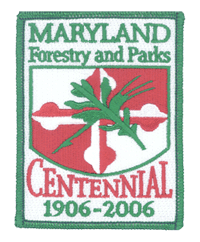 The Civilian Conservation Corps
The Civilian Conservation Corps
Roosevelt's Tree Army in Maryland
Part III: 100th Anniversary CCC Plaque Dedication and Personal
Perspectives
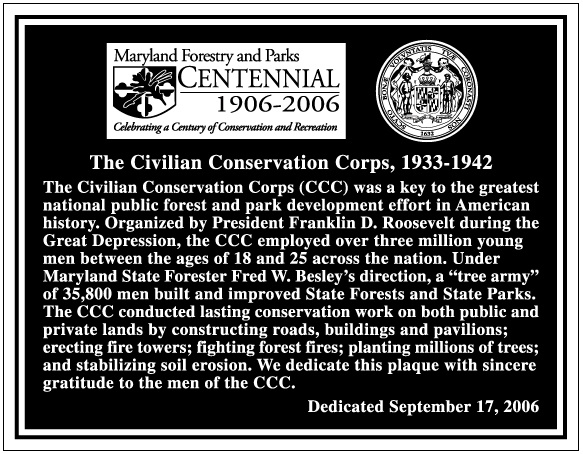
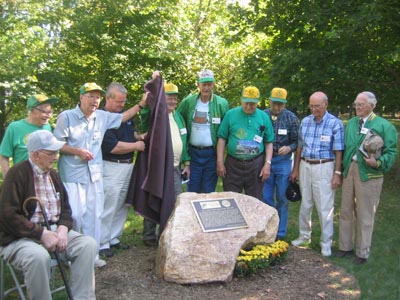
On
Sept. 17, 2006, nine veterans of Roosevelt's Civilian Conservation Corps joined DNR Secretary Ron Franks for the commemoration of their efforts with a new plaque at Gambrill State Park.
Remarks by DNR Secretary Ronald C.
Franks
The Civilian Conservation Corps -- truly one of the most spectacularly
successful public works project in American history -- was born of the
despair of the Great Depression in the 1930s. It was the era of soup
kitchens, Hoover Villages, and “The Grapes of Wrath.”
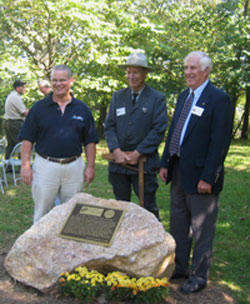 Part
of President F.D. Roosevelt’s famous “Hundred Days Legislation” to get the
nation back on its feet was the Emergency Work Act, one aspect of which
established the CCC. The CCC recruited millions of young, unemployed men
across the nation to perform conservation work in forests, parks, on
waterways and even on private property, to reclaim the nation’s natural
resource base. Government could work amazingly fast in those days: FDR
signed the Emergency Work Act on March 27, 1933, and the first camp opened
in Virginia only 21 days later! By the first of July, 270,000 enrollees
were serving in 1,300 camps across the nation.
Part
of President F.D. Roosevelt’s famous “Hundred Days Legislation” to get the
nation back on its feet was the Emergency Work Act, one aspect of which
established the CCC. The CCC recruited millions of young, unemployed men
across the nation to perform conservation work in forests, parks, on
waterways and even on private property, to reclaim the nation’s natural
resource base. Government could work amazingly fast in those days: FDR
signed the Emergency Work Act on March 27, 1933, and the first camp opened
in Virginia only 21 days later! By the first of July, 270,000 enrollees
were serving in 1,300 camps across the nation.
The CCC boys were organized into 200-man companies, and assigned work
camps across the nation. The U.S. Army provided discipline, camp officers,
quarters, food, and medical care. Federal, state and local authorities
designated work projects, trained the boys to do the work, and provided
oversight of the work. The boys themselves received discipline, hearty
food, clothing, shelter, medical care, educational opportunities, and,
most importantly of all, a sense of hope and purpose. Their monthly pay
was $30 -- $25 of which was sent home to their families. These pay
disbursements alone had a significant impact on the national economy.
By the time World War II superseded the CCC, nearly 3 million young men
had served, and they had enhanced millions of acres of natural resources
and historic sites across the nation.
Maryland benefited hugely from the CCC. Over 30,000 CCC boys served in
our state, at over 60 camps. Together they:
- built 274 bridges;
- constructed 3,500 erosion check dams;
- planted four and a half million trees;
- improved over 60,000 acres of forests stands;
- and reduced fire hazards on over 23,000 acres.
The CCC boys also built the first major state park facilities in Maryland:
- Herrington Manor (cabins and lake)
- Swallow Falls (pavilions, trails, camp sites)
- Big Run
- New Germany (cabins, lake, pavilions)
- Gambrill (all you see here, including this overlook where we are
standing, was built by the CCC)
- Elk Neck (cabins)
- Fort Frederick (the fort’s walls were restored and support
facilities built)
- Washington Monument (the monument was reconstructed, picnic
pavilions and support facilities were built)
- Patapsco Valley (trails and pavilions)
- Cedarville
- Pocomoke (a public fishing pier)
If ever a debt of gratitude was owed by a present generation to a past
one, our nation and state owe a huge one to the work of the Civilian
Conservation Corps.
- Address delivered by C. Ronald Franks, Secretary
Maryland Department of Natural Resources
Gambrill State Park, Sept. 17, 2006
Park Service Veterans Gather for Reunion
By Geoffrey D. Brown
News-Post Staff
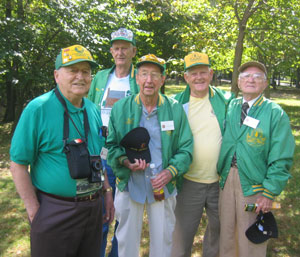 FREDERICK — Clarence
Simmons, 88, stood a few yards from Gambrill State Park's Frederick
Overlook and admired the stone he hauled almost 60 years ago.
FREDERICK — Clarence
Simmons, 88, stood a few yards from Gambrill State Park's Frederick
Overlook and admired the stone he hauled almost 60 years ago.
Maryland's parks are
what they are in large part due to the work of almost 40,000 young men who
swept into the state from 1933 to 1942 and labored in dozens of camps,
restoring forests, building shelters and cabins and fire towers, blazing
trails and fighting fires.
On Sunday nine veterans
of President Franklin D. Roosevelt's storied Civilian Conservation Corps
returned for the commemoration of their efforts with a new plaque at
Gambrill State Park. Fifteen had been invited. One had died since the
invitations were sent.
The ceremony was part of
the Maryland Park Service's 100th anniversary celebration. Joining the
ceremony also were family members of Maryland's first State Forester, Fred
W. Besley, who was among a handful of conservationist pioneers nationwide.
Mr. Besley had a staff
of 25 at most before the CCC boys arrived. The "tree army" of unemployed
boys and young men earned $30 a month to start — $25 of it sent home to
family — in Roosevelt's jobs program, which aimed to restore the land and
put unemployed men to work.
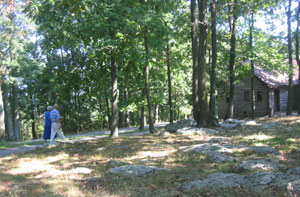 "It was the greatest
shot in the arm the young forestry department could have had," said Offutt
Johnson, a retired state naturalist who worked closely with Frederick
County officials to establish and improve parks in the county.
"It was the greatest
shot in the arm the young forestry department could have had," said Offutt
Johnson, a retired state naturalist who worked closely with Frederick
County officials to establish and improve parks in the county.
Mr. Simmons, who now
lives in Hagerstown, worked in several state parks, and drove a truck
carrying rock to construction sites, and ferrying workers to and from the
camp on what is now Old Camp Road.
Joe Bianchini, 85, of Mount Rainier, visited with his wife Anita, and they both recalled their own service to the country. Mr. Bianchini, who grew up in the Bronx, New York City, took the train with 500 CCC boys and wound up in Idaho, where
he repaired roads. Ms. Bianchini was a riveter at an airplane factory
during World War II.
John Patrick Curley, 89, of Spring Ridge spent six years in eight camps and learned what was to be his lifelong trade as an operating engineer, running heavy construction equipment.
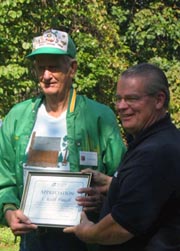 Joseph Decenzo, 88, of
Clinton, Md., was a camp clerk, became a leader at the Sligo, Pa. camp at a whopping $45 a month, and was a star on camp baseball, softball and basketball teams. Keith Paugh, 81, of Middle River, Md., was a truck driver at the New Germany, Md. camp, and made $36 a month as an assistant leader.
Joseph Decenzo, 88, of
Clinton, Md., was a camp clerk, became a leader at the Sligo, Pa. camp at a whopping $45 a month, and was a star on camp baseball, softball and basketball teams. Keith Paugh, 81, of Middle River, Md., was a truck driver at the New Germany, Md. camp, and made $36 a month as an assistant leader.
"I didn't spend all the
money, either, did you?" Mr. Paugh asked Mr. Decenzo.
"No, I didn't either,"
Mr. Decenzo said.
A movie cost 15 cents, a
pack of cigarettes a nickel.
George Smith, 81, of
Bowie, showed off a small, battered tin frame with a black-and-white photo
of himself in his CCC uniform, aged 18. The photo and frame cost a dime.
Mr. Smith joined the CCC while still in high school in June of 1941. In
September he went back to school. That December, the Japanese bombed Pearl
Harbor, and in January 1942 Mr. Smith joined the Navy.
In Maryland, the CCC
built 274 bridges, installed 3,500 check dams to preserve trails, planted
4.5 million trees, and improved over 60,000 acres of park land.
"All you see here,
including this overlook where we're standing, was built by the CCC boys,"
C. Ronald Franks, secretary of the Maryland Department of Natural
Resources, told the gathering.
"Our nation and our
state owe a debt of gratitude to the CCC."
Note: The above article, "Park service veterans gather for
reunion," by Geoffrey D. Brown, News-Post Staff
is reprinted here with permission of the Frederick News-Post and Randall
Family, LLC as published on September 18, 2006. Maryland DNR and the
Centennial Committee would like to thank Mr. Brown for his thorough
coverage of this event.
New Germany Remembers the CCC
By Bill Martin
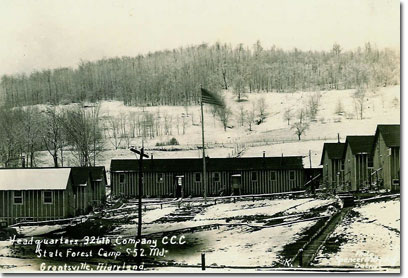 One bright, sunny
morning in June 1933 a convoy of covered stake-body and dump trucks
appeared at New Germany. They carried tents, field kitchen, water
purification equipment, clothing, tools and a cadre of regular army
enlisted men from Fort Meade. New Germany was designated Civilian
Conservation Corps (CCC) Company 326, S-52.
One bright, sunny
morning in June 1933 a convoy of covered stake-body and dump trucks
appeared at New Germany. They carried tents, field kitchen, water
purification equipment, clothing, tools and a cadre of regular army
enlisted men from Fort Meade. New Germany was designated Civilian
Conservation Corps (CCC) Company 326, S-52.
The trucks would be used
to transport the company of CCC enlistees to the temporary site. All
equipment and supplies were off-loaded into the field and the covered
trucks were dispatched to Meyersdale, PA. The men had traveled from
Baltimore via the B&O Railroad. The convoy returned in late afternoon with
a bedraggled crew. Some of the men had never been out of the city before
and were unprepared for camp life.
The minimum age for
enlistment was 18, but in the camp at New Germany there were frequently
lads of 14 and 15. Enlistment was for six months but could be extended.
The first problem was
providing shelter for 150 men. Piles of canvas laying on the ground, their
new homes, had to be assembled before they could sleep. A field kitchen
was set up and supper served. Bedding was issued. Eight to a tent, the men
were bedded down for the night. In addition to the usual complement of 120
men, there was a first sergeant, supply sergeant, mess sergeant and
company clerk. Officers included a company commander, adjutant and doctor.
These were reserve officers called to active duty by Congress.
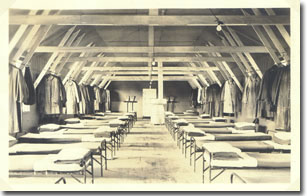 The tent city included
squad tents, officers' tents and supply tent. The orderly room and
dispensary tents were then set up for operation. The field kitchen was in
the center. All meals were served from that facility. Slit trenches were
used initially and later outside toilets were built.
The tent city included
squad tents, officers' tents and supply tent. The orderly room and
dispensary tents were then set up for operation. The field kitchen was in
the center. All meals were served from that facility. Slit trenches were
used initially and later outside toilets were built.
All water was trucked
into the camp. Drinking water was available in Lister bags throughout the
camp. The only bath facility was the lake. After several days
orientation, the boys were issued: clothing and equipment. This included
a mess kit - two flat pans hinged together, a knife, fork and spoon, solid
aluminum cup and a canteen.
Each boy was issued blue
dungaree trousers, coats and a round blue hat as a work uniform. Olive
drab (OD) shirts and pants completed the dress uniform. An overseas hat
and overcoat were issued later in the year. Other wardrobe items included
a raincoat, galoshes, ties, gloves, shoes, socks, underwear towels and
long johns.
At the onset everything
was one size (too big). It took some time to fit each individual. But
everyone had something to wear.
The first big project
was to build platforms for the tents. The tents were erected on the
platforms. When stretched tightly and tied down, it was very cozy
inside. A space heater was installed in each tent. The first winter at
New Germany was spent in tents.
The field kitchen served
three meals each day. Kerosene stoves were used for cooking. A large
gasoline generator in the woods east of the tent city provided
electricity. It supplied power for the Refrigerators, officers' tents,
dispensary and orderly room. Enlistees used candles and kerosene lanterns
in the squad tents.
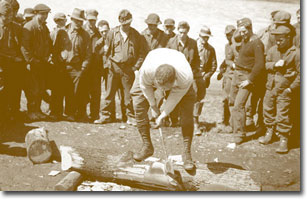 At mealtime, the entire
company would assemble in a line at the field kitchen. Meals were served
cafeteria style. In inclement weather, mess kits were carried back to the
tents. At other times, the CCC boys ate under the shade of the nearest
tree. The quality and quantity of the food served from the field kitchen
was outstanding. Most boys never ate any better at home. Most of the
food was locally produced.
At mealtime, the entire
company would assemble in a line at the field kitchen. Meals were served
cafeteria style. In inclement weather, mess kits were carried back to the
tents. At other times, the CCC boys ate under the shade of the nearest
tree. The quality and quantity of the food served from the field kitchen
was outstanding. Most boys never ate any better at home. Most of the
food was locally produced.
After eating, the boys
sterilized their kits. They scrubbed their kits in a can of boiling soapy
water and then double-rinsed in a can of clear boiling water.
Periodically they scoured kits with sand to shine them. Woe unto anyone
found with a dirty mess kit.
One of the first
permanent buildings was the mess hall. Construction began in the fall of
1933. The building was 200 by 30 feet with the kitchen about halfway on
the east side. At the north end the supply room held staples and canned
goods and a refrigerated compartment. The south end was the officers’
mess.
The kitchen was modern. Hotel ranges fired with coal were used for cooking and baking. A serving
line formed on the east side of the mess. Picnic tables were used in the
hall. A generator supplied lights. Heat came from three large space
heaters.
After several months of
operation, the camp commander enlisted local men as trainers and
supervisors. This category of enlistees, known as local experienced men (LEMs),
was permitted to live at home. They earned several dollars more per
month, wore uniforms and were subject to the same rules and regulations as
the others.
Next came the
construction of permanent quarters. Local carpenters supervised
construction of six 80 by 30 feet barracks on poles east of the recreation
hall. There were three barracks on each side, with a company area and
flag pole in the center.
These barracks were not
occupied by the company members until late spring 1934. The winter spent
in tents acquainted everyone with the hardships of winter.
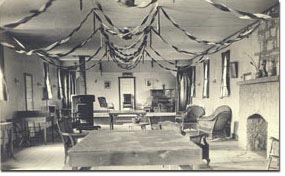 The recreation hall was the
center of camp life. The rec hall is little changed from when it was
built. There were several pool tables and tennis table games. Books and
writing materials were available. Gambling was prohibited, but there was
usually some sort of card game being played. The canteen was located in
the alcove that now houses the snack bar. It was open daily and catered to
personal needs. North of the recreation hall was a combination bath
house/toilet. This heated facility was welcome after almost a year
without showers or toilet facilities.
The recreation hall was the
center of camp life. The rec hall is little changed from when it was
built. There were several pool tables and tennis table games. Books and
writing materials were available. Gambling was prohibited, but there was
usually some sort of card game being played. The canteen was located in
the alcove that now houses the snack bar. It was open daily and catered to
personal needs. North of the recreation hall was a combination bath
house/toilet. This heated facility was welcome after almost a year
without showers or toilet facilities.
The barracks were
not occupied by the company members until late spring 1934. The winter
spent in tents acquainted everyone with the hardships of winter. By early
summer of 1934, the majority of the permanent buildings had been completed
and were in use.
With most of the
buildings completed, the CCC boys formed crews to build roads. These
included from the top of Savage
Mountain to the High Rock Tower. In the winter, most of the roads were
shoveled by the CCC boys. Snow plows did not venture onto the back roads.
The timber used to build
the cabins and picnic shelters was cut and sawed by Sam Otto on his
sawmill. Fire control was another duty during fire season.
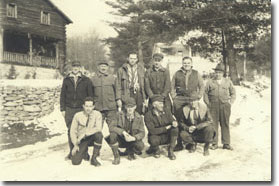 In the winter, most of
the roads were shoveled by the CCC boys. Snow plows did not venture onto
the back roads. Camp personnel eventually built a wooden snow plow pulled
by a small tractor. The summer of 1934 saw the rebuilding of the
breast of the lake. It was just a jumble of rocks stumps and logs. The
lake was completely drained and the existing breast completely removed.
The present earthen breast works were built along the spillway.
In the winter, most of
the roads were shoveled by the CCC boys. Snow plows did not venture onto
the back roads. Camp personnel eventually built a wooden snow plow pulled
by a small tractor. The summer of 1934 saw the rebuilding of the
breast of the lake. It was just a jumble of rocks stumps and logs. The
lake was completely drained and the existing breast completely removed.
The present earthen breast works were built along the spillway.
The lake was drained
several times between 1934 and 1938 for purpose of stump and log removal. The bigger fish were taken to Sam
Otto's pond. It was not unusual to catch brown and rainbow trout from the
catch pen below the spillway that were 30 inches in length. Most other
fish were allowed to enter Poplar Lick and eventually made their way into
Savage River.
Most boys gave a day's
work for a day's pay. Foremen did not work anyone beyond his ability.
Malingerers, gold brickers and malcontents were 'fired' from their jobs
and returned to camp. They cleaned out grease traps in the kitchen or
joined the "honey bucket brigade" cleaning out the toilets. After several
days they were overjoyed to return to their job on the road or in the
woods. Periodically, a vaudeville show would perform at the camp. This
was usually well attended by both camp personnel and local citizens.
The generators were shut
down after 9 p.m. One was kept running to provide lights for fire exits
and the orderly room. "Lights out” was strictly observed. Some
individuals circumvented this policy by hiding under the covers with a
flashlight to read or write letters.
Church services were
held at the rec hall on Sunday providing there was a chaplain available.
He was known as "Holy Joe." If no chaplain was available, those who wished
to attend church were taken to local churches. Movies were shown in the
rec hall several times each week. They were free to the camp personnel.
Local citizens were charged five cents. If you didn't have the nickel,
you were welcome anyway. Saturday night was a special night. This was
Liberty Run night. The boys were loaded into the covered trucks and taken
to Frostburg or Lonaconing.
Being close to a body of
water was a great temptation to many of the boys. Some of them could not
swim so in the summer of 1934, and every summer thereafter, water safety
courses and swimming instruction were given to anyone who was interested.
In 1938, CCC Company 326
at New Germany was disbanded. All men and equipment was moved to Meadow
Mountain camp, S-68.
Note: This story
originally appeared in the Fall 1990 issue of Parkline. Billy Martin grew
up working at the newly-created New Germany State Park with his father,
the first state forester at Savage River State Forest. After World War
11, Martin worked at New Germany and Patapsco before reenlisting in the
Air Force from which he retired in 1965. He returned to the Grantsville
area and beginning in 1985 he served as a contractual employee 10 months out of
the year at New Germany. He volunteered his time during the other two
months and inherited the job of historical interpreter.
Acknowledgements:
The editor of this article gratefully acknowledges the
following persons whose contributions made it possible to present this
perspective of the CCC in Maryland. Where errors may occur, Maryland DNR
will sincerely appreciate any corrections, clarification or additional
comments from former CCC members and their families, or from historians
who may have a more accurate factual record.
-
"Park service veterans gather for reunion,"
by Geoffrey D. Brown, Frederick News-Post,
is reprinted
here with permission of the Frederick News-Post and Randall Family, LLC as
published on September 18, 2006. Maryland DNR and the Centennial
Committee would like to thank Mr. Brown for his thorough coverage of this
event.
-
"New Germany Remembers the CCC," by Billy Martin. This story
originally appeared in the Fall 1990 issue of Parkline. Billy Martin grew
up working at the newly-created New Germany Recreation Area with his father,
Matthew Ellis Martin, the first Resident Warden at Savage River State Forest. After World War
11, Martin worked at New Germany and Patapsco before reenlisting in the
Air Force from which he retired in 1965. He returned to the Grantsville
area and beginning in 1985 he served as a contractual employee 10 months out of
the year at New Germany. He volunteered his time during the other two
months and inherited the job of historical interpreter.
-
Photos of New Germany CCC S-52 provided with notations.
Offutt Johnson... spent most of his 35-year career with the Department
of Forest and Parks and the Dept. of Natural resources in Annapolis, Md.
For 26 of those years he worked for Program Open Space. His last ten
years with DNR, Mr. Johnson was involved in nature and history projects,
most notably at Patapsco Valley State Park where he directed the
renovation of an old stone iron workers' house into the Park's first
history center for visitors. He and his wife Joan moved to Oakland after
his retirement. He continues to volunteer by working on a history of
Maryland's state forests and parks.
Photographs (top to bottom):
- Nine veterans of the CCC with DNR Secretary Ron Franks
unveiling the CCC Centennial Plaque at Gambrill State Park, Sept. 17,
2006
- DNR Secretary Ron Franks, Francis Zumbrun as "Abraham
Lincoln Sines" in original
Maryland State Forester uniform, and Fred W. Besley, III, grandson of the
first Maryland State Forester at the CCC Centennial Plaque ceremony in at
Gambrill State Park, Sept. 17, 2006
- Pictured (l to r) are CCC Alumni, Joseph DeCenzo, Keith
Paugh, John Patrick Curley, George Smith, and Marvin Warnick.
- CCC Alumni and wife, walking to the Tea House, one of the
buildings erected by the CCC at Gambrill State Park in the thirties.
- Keith Paugh, CCC veteran who served at the New Germany CCC
Camp S-52, among others in Western Maryland, receiving a commemorative
Centennial certificate from DNR Secretary Ron Franks, Sept. 17, 2006
- New Germany CCC Camp S-52, Headquarters & Barracks of
326th Company, 1936
- New Germany CCC Camp S-52, typical Barracks Interior, 1935
- New Germany CCC boys (Camp S-52) observing an ax
demonstration
- Interior - CCC New Germany Rec Hall 1936
Resident Warden Matthew Ellis Martin (2nd row, far left)
and the CCC Camp Technical staff Camp S-52, 1936, Photo by H. C.
Buckingham, District Forester